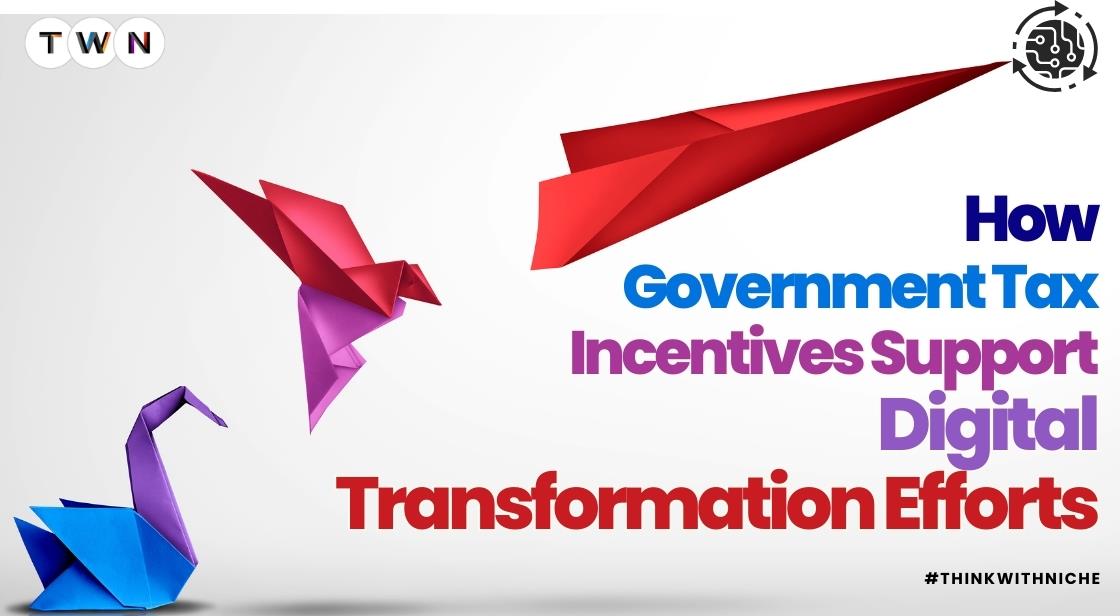How Government Tax Incentives Support Digital Transformation Efforts

Blog Post
Digital transformation is no longer optional- it is the foundation for long-term survival in today’s hyper-competitive world. But with innovation comes cost. This blog uncovers how government-backed tax incentives are fueling smarter, faster, and more affordable digital adoption- turning transformation challenges into real business opportunities.
Why Tax Incentives Are the Hidden Engine Behind Digital Transformation
The High Cost of Innovation
Shifting from legacy systems to advanced digital technologies demands hefty investments- new software, modern infrastructure, cybersecurity upgrades, and workforce training.
For many organizations, these costs pose a significant barrier to progress. This is where tax incentives act as a strategic lifeline, lowering entry barriers and accelerating adoption of cutting-edge solutions.
How Policy Meets Progress
Governments worldwide recognize that digital transformation boosts competitiveness, strengthens industries, and fosters job creation. By offering tax credits, rebates, and financial offsets, policymakers create an environment where businesses can experiment with emerging tools such as artificial intelligence, IoT, blockchain, and advanced analytics without excessive financial risk.
Building Skills for the Future
True transformation does not stop at installing new systems- it requires people with the knowledge to maximize them. Tax schemes that fund employee training ensure that organizations not only invest in technology but also empower their workforce with the digital fluency needed to thrive in tomorrow’s economy.
Collaboration as a Catalyst
Incentives also spark cross-industry collaborations.
By reducing the financial burden of research and partnerships, governments encourage businesses, universities, and research labs to co-develop innovative digital solutions. These synergies shorten development cycles and create scalable outcomes that benefit entire industries.
Why You Must Read This Blog Post
This blog post/ article is essential reading for entrepreneurs, policymakers, and business leaders seeking to understand how fiscal policies directly impact digital growth.
You will learn how tax incentives bridge the gap between ambition and execution, why they are critical for building resilient economies, and how they enable companies to remain competitive in a fast-changing global marketplace.
Digital transformation has emerged as a crucial priority of businesses across most industries as organizations integrate emerging technologies that help it to better its efficiency, customer experiences as well as remain competitive in the more interconnected environment. The changes usually involve major investments such as software, hardware, training, and process redesign, which tends to push the budgets of a company to its limits. In order to ease this burdensome cost, most governments offer tax schemes that aid innovation and modernization.
Such government initiatives should bring motivation to business owners to use high-level digital tools, explore new ideas, and use technology in their business activity. Tax incentives can help more entities to take a bold move toward digital transition as the financial cost is reduced. This support does not only help individual businesses but also contributes to the nationwide economic growth due to the fact that it leads to innovation in many sectors.
Encouraging Technology Adoption
Among the most straightforward examples of how government tax incentives are helping with digital transformation, one should mention the fact that the adoption of new technologies typically changes the financial feasibility of such technologies. Most companies are afraid to invest in quality systems due to the substantial investments at the onset of the investments despite knowing the future gains. These barriers are decreased through tax credits where companies can implement digital solutions faster and on a bigger scale.
The areas of investment that can be supported by incentives vary significantly, and can include cloud infrastructure, data analytics systems, automations systems and high-level cybersecurity tools. To illustrate, such programs as SRED could be applicable to some software development projects, especially where they engage in developing solutions or otherwise, the improvement of the solutions and systems. This form of financial aid assists firms to transition even faster to the activity of execution.
Supporting Research And Development In Digital Solutions
Digital transformation is usually not as simple as simply buying off the shelf software. Numerous organizations require tailoring solutions or creating their own unique solutions to unique problems of business. The availability of such efforts is greatly assisted by the government tax favors given to research and development. The financial gain can be invested in experiment, testing, and technical problem solving that is necessary in digital innovation.
The programs do not only give some instant sanction to cost relief but they also foster a culture of continual littering. Incentives will eliminate the risk relating to investing in untested digital solutions thereby enabling companies to adopt emergent technologies, including artificial intelligence, blockchain, and Internet of Things without the fear of losing their finances on failures. This creates an atmosphere in which innovations can be encouraged as opposed to being something to be feared.
Enabling Workforce Upskilling
The technology required to achieve a successful digital transformation is not the only deciding factor to its success, but also the people using it. Introduction of new systems usually demands that the employees become conversant with new tools, as well as new work routines and acquisition of new technical skills. Tax incentives provided by the government can also contribute to offsetting the expenditure of training and upskilling the personnel so that they are ready to work in a modernized workplace environment.
These incentives lower the costs of training such that organizations do not slow productivity when they need to integrate a new system. The result is an increased level of skills which has the potential of boosting job satisfaction and career opportunities to the employees and ease of technology integration and increased digital investment returns to the employers.
In the long term, such a combination of skillful talent with highly developed tools makes a much better competitive advantage.
Encouraging Collaboration And Industry Partnerships
The programs on digital transformation usually entail several stakeholders, including technology suppliers or laboratories. Tax incentives by the government can stimulate cooperation of business industry and academia where joint projects can come with greater benefits to both parties. This philosophy enables firms to exchange resources, cut down on the expenses, and hasten development cycles.
Partnerships also facilitate combating complex problems that a company may view as very huge or too expensive to face collectively. An instance is that businesses which collaborate with the universities are subject to advanced research facilities and expert knowledge, whereas the academic partners obtain real life applications of their work. Rewards that motivate such collaboration are useful in making sure that the digital transformation initiatives are innovative, and practical.
Driving Competitiveness And Economic Growth
The benefit of tax incentives encourages businesses to rapidly go through the digital transformation process, but the effect goes beyond the organization. Industries are also increasingly competitive as more firms have shifted towards adopting superior technologies. Its higher performance in terms of efficiency and better quality of products, as well as a quicker pace of innovation results in better economic performance and increased job creation.
Digital transformation also results in a more resilient economy which is beneficial to the governments. The updated companies find it more difficult to adjust to new conditions on the market, to resist it, and take opportunities. Through their investments in policies that attract advances in technology, policy makers are developing conditions to ensure sustainable growth through economic structures.
Conclusion: Turning Incentives Into Innovation
Tax incentives by governments have been critical in ensuring that businesses, big or small are enabled to undergo digital transformation. They lower the cost of adopting technology, assist in the research and development activities as well as in training the workforce. Moreover, they promote cooperation between various stakeholders to result in more creative and efficient solutions.
Such initiatives as SRED (Scientific Research and Experimental Development) show how purposeful incentives can make businesses take some risky steps to modernize without putting the entire financial burden on themselves.
For businesses, leveraging these schemes is more than an accounting move- it is a strategic decision that accelerates innovation, strengthens resilience, and amplifies global competitiveness.
For economies, these incentives foster inclusive growth, stimulate job creation, and ensure industries remain agile in an unpredictable digital-first world.
As the pace of technological change continues to accelerate, the partnership between government policy and business innovation will become even more critical. Organizations that capitalize on these opportunities today will not only thrive but also help shape the digital economy of tomorrow.
Key Takeaways for ThinkWithNiche Readers
- Reduced Barriers: Tax incentives lower upfront technology adoption costs.
- Boosting R&D: Government support encourages experimentation with new digital solutions.
- Workforce Upskilling: Training incentives align people with modern digital tools.
- Stronger Partnerships: Incentives promote collaboration between businesses, academia, and tech providers.
- National Growth Impact: Widespread digital adoption enhances competitiveness, job creation, and economic resilience.
Reader’s Disclaimer: This blog post is intended purely for knowledge-sharing. ThinkWithNiche does not promote or endorse any company, product, or individual mentioned in the content. Readers are advised to seek professional financial or legal guidance before making decisions based on government tax schemes or policies.
You May Like
EDITOR’S CHOICE












